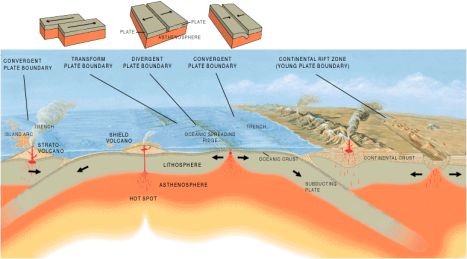
You might have studied, or might be studying, a general introduction to tectonic plates inside the Earth’s surface during your school years. These geological objects undergo an interesting environmental phenomenon, technically called tectonic plate movements. It is a common thing that keeps on going beneath the Earth’s surface in different regions across the world. Only those plate movements that are impulsive enough are experienced on the surface.
Tectonic plate movements yield several phenomena, most notably earthquakes, tsunamis and volcanoes. Let’s learn a more about seemingly chaotic tectonic plate movements before discussing why they cause earthquakes.
The Crust
The thin but solid layer from where the Earth’s surface actually starts is known as the crust. You can compare earth’s crust with the skin of a fruit. Nonetheless, unlike fruit skin, the crust is not a whole entity i.e. it is divided into several distinct pieces, known popularly and academically as the tectonic plates.
The Mantle
Directly below the crust, there is a thick layer of steaming hot liquid that can reach temperatures at a scorching 40000C. This layer is known as the mantle. It separates crust from the outer portion of the Earth’s core. As liquids are viscous, the mantle moves more frequent than the crust and hence is responsible for causing tectonic plates sitting on top of it to move along with it.
Tremors beneath the Crust
Tectonic plates are giant geological structures. As such, when they crash into one another, tremors are sent towards the Earth surface. The more intense the tectonic collision is, the more powerful impact it will yield. These chaotic impulses sent by the collisions can take the form of natural calamities like earthquakes, volcanic eruptions and tsunamis over the surface.
Earthquakes
Even though earthquakes can take place across various regions on the Earth, these occur frequently in a specific geological region known as The Ring of Fire. As a matter of fact, most volcanoes are found in the same region, hence giving the region its hyped name. At this region, most interactions between the tectonic plates occur and hence cause more earthquakes. In the most hostile regions of tectonic activities, tremors are very frequent.
An earthquake is analogous to a game of Tug of War. Tectonic plates tuck together and move yielding tension. Suddenly, plates slip each other, break free, and result into sending all the tension buildup across all directions. We aren’t able to experience the tension under the Earth surface but above it, this tension causes quaver and shakings in the form of earthquakes and sometimes tsunamis and volcano eruptions.